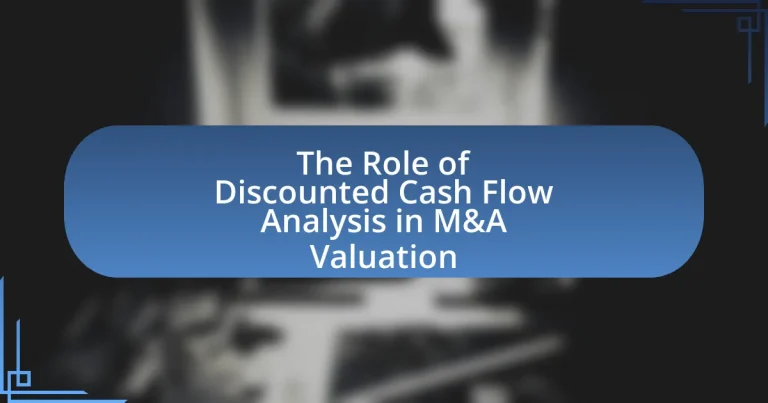Discounted Cash Flow (DCF) Analysis is a critical financial modeling technique used in mergers and acquisitions (M&A) to estimate the intrinsic value of a target company based on its projected future cash flows, adjusted for the time value of money. The article outlines the functioning of DCF in M&A, emphasizing its key components such as cash flow projections, discount rates, and terminal value. It discusses the importance of DCF in providing a systematic approach to valuation, its advantages over other methods, and the challenges analysts face, including forecasting accuracy and discount rate selection. Additionally, the article highlights best practices for conducting DCF analysis and its practical applications in real-world M&A transactions, supported by case studies and industry-specific insights.

What is Discounted Cash Flow Analysis in M&A Valuation?
Discounted Cash Flow (DCF) Analysis in M&A Valuation is a financial modeling technique used to estimate the value of a target company based on its expected future cash flows, adjusted for the time value of money. This method involves projecting the company’s cash flows over a specific period and discounting them back to their present value using a discount rate, typically the weighted average cost of capital (WACC). The accuracy of DCF Analysis is supported by its reliance on fundamental financial principles, as it reflects the intrinsic value of a business by considering both the potential growth of cash flows and the risks associated with those cash flows.
How does Discounted Cash Flow Analysis function in the context of M&A?
Discounted Cash Flow (DCF) Analysis functions in M&A by estimating the present value of a target company’s future cash flows, which aids in determining its fair market value. This method involves projecting the company’s cash flows over a specific period and discounting them back to their present value using a discount rate that reflects the risk of those cash flows. For instance, if a company is expected to generate $10 million in cash flow annually for the next five years, and the appropriate discount rate is 10%, the present value of those cash flows would be calculated to assess the company’s worth in an acquisition scenario. DCF is widely used in M&A because it provides a detailed and intrinsic valuation based on the company’s operational performance, making it a critical tool for buyers and sellers in negotiations.
What are the key components of Discounted Cash Flow Analysis?
The key components of Discounted Cash Flow (DCF) Analysis are cash flow projections, discount rate, and terminal value. Cash flow projections involve estimating the future cash flows that a business is expected to generate, typically over a period of five to ten years. The discount rate reflects the risk associated with those cash flows and is often derived from the weighted average cost of capital (WACC). Terminal value accounts for the value of cash flows beyond the projection period, often calculated using either the perpetuity growth model or the exit multiple method. These components collectively enable the valuation of a business by determining its present value based on expected future cash flows.
How is cash flow projected in M&A scenarios?
Cash flow in M&A scenarios is projected through a detailed analysis of historical financial performance, future revenue growth estimates, and cost structures. This projection typically involves creating a financial model that incorporates assumptions about market conditions, operational efficiencies, and potential synergies from the merger or acquisition. For instance, firms often utilize discounted cash flow (DCF) analysis, which calculates the present value of expected future cash flows, adjusting for risk and time value of money. According to a study by Koller, Goedhart, and Wessels in “Valuation: Measuring and Managing the Value of Companies,” accurate cash flow projections are critical for determining the fair value of a target company in M&A transactions.
Why is Discounted Cash Flow Analysis important for M&A valuation?
Discounted Cash Flow (DCF) Analysis is important for M&A valuation because it provides a systematic approach to estimating the intrinsic value of a target company based on its expected future cash flows. This method allows acquirers to assess the financial viability and potential return on investment of the acquisition by discounting projected cash flows back to their present value, thus accounting for the time value of money. Empirical studies, such as those published in the Journal of Finance, demonstrate that DCF analysis often yields more accurate valuations compared to market-based approaches, particularly in cases where market conditions are volatile or when the target company operates in a niche market.
What advantages does it provide over other valuation methods?
Discounted Cash Flow (DCF) analysis provides several advantages over other valuation methods, primarily its focus on intrinsic value based on projected cash flows. This method allows for a detailed assessment of a company’s future financial performance, incorporating specific assumptions about revenue growth, expenses, and capital expenditures. Unlike market-based approaches, which may be influenced by market sentiment or external factors, DCF relies on fundamental financial data, making it a more objective valuation tool.
Additionally, DCF analysis can accommodate varying scenarios and sensitivity analyses, enabling analysts to evaluate how changes in assumptions impact valuation. This flexibility is particularly beneficial in mergers and acquisitions, where future cash flows are critical for determining the fair value of a target company. The reliance on cash flow projections also aligns with the ultimate goal of any business: generating cash for stakeholders, thus providing a clearer picture of long-term value creation.
How does it enhance decision-making in M&A transactions?
Discounted Cash Flow (DCF) analysis enhances decision-making in M&A transactions by providing a quantitative framework to assess the intrinsic value of a target company. This method allows acquirers to estimate future cash flows generated by the target and discount them to present value, facilitating a more informed valuation. For instance, a study by Aswath Damodaran, a leading finance professor, emphasizes that DCF analysis helps identify whether a target is undervalued or overvalued based on its projected financial performance. By relying on this structured approach, decision-makers can mitigate risks associated with subjective valuations and make strategic choices that align with their financial objectives.

What are the challenges of using Discounted Cash Flow Analysis in M&A Valuation?
The challenges of using Discounted Cash Flow (DCF) Analysis in M&A Valuation include the difficulty in accurately forecasting future cash flows, selecting an appropriate discount rate, and the sensitivity of the valuation to these inputs. Forecasting future cash flows is inherently uncertain, as it relies on assumptions about market conditions, revenue growth, and operational performance, which can vary significantly. Additionally, determining the discount rate involves estimating the weighted average cost of capital (WACC), which can be complex and subjective, leading to potential inaccuracies. Studies have shown that small changes in cash flow projections or discount rates can lead to substantial differences in valuation outcomes, highlighting the sensitivity of DCF Analysis.
What common pitfalls should analysts be aware of?
Analysts should be aware of several common pitfalls in discounted cash flow (DCF) analysis during M&A valuation. One significant pitfall is overestimating future cash flows, which can lead to inflated valuations; studies show that overly optimistic projections are a frequent cause of valuation errors. Another common mistake is using an inappropriate discount rate, as this can misrepresent the risk associated with the cash flows; for instance, using a company’s historical cost of capital instead of the weighted average cost of capital can distort the analysis. Additionally, analysts often neglect to account for changes in working capital, which can significantly impact cash flow projections; research indicates that overlooking these adjustments can lead to substantial inaccuracies in valuation. Lastly, failing to conduct sensitivity analysis can result in a lack of understanding of how changes in assumptions affect the valuation outcome, which is critical for informed decision-making in M&A transactions.
How can inaccurate cash flow projections impact valuation?
Inaccurate cash flow projections can significantly distort a company’s valuation by leading to incorrect assessments of its future financial performance. When cash flow estimates are overly optimistic or pessimistic, they can result in inflated or deflated valuations, respectively. For instance, a study by Aswath Damodaran, a professor of finance at NYU Stern, highlights that a 10% error in cash flow projections can lead to a valuation error of up to 30% in discounted cash flow analysis. This misalignment can affect investment decisions, merger negotiations, and overall market perception, ultimately impacting the financial health and strategic direction of the company involved in M&A transactions.
What role does discount rate selection play in the analysis?
Discount rate selection is crucial in discounted cash flow (DCF) analysis as it directly affects the present value of future cash flows. A higher discount rate reduces the present value, indicating a higher perceived risk or cost of capital, while a lower discount rate increases the present value, suggesting lower risk or cost. This selection influences investment decisions, valuation accuracy, and ultimately the perceived attractiveness of a merger or acquisition. For instance, according to a study by Damodaran (2021), variations in discount rates can lead to significant differences in valuation outcomes, underscoring the importance of careful selection in financial analysis.
How can these challenges be mitigated?
Challenges in discounted cash flow (DCF) analysis during M&A valuation can be mitigated by employing sensitivity analysis and scenario planning. Sensitivity analysis allows analysts to understand how changes in key assumptions, such as growth rates and discount rates, impact valuation outcomes. For instance, a study by Damodaran (2012) highlights that varying the discount rate by just 1% can significantly alter the valuation, emphasizing the need for thorough examination of assumptions. Scenario planning further enhances this by evaluating different future states, enabling decision-makers to prepare for various potential outcomes. By integrating these methods, firms can reduce uncertainty and improve the reliability of their DCF valuations in M&A transactions.
What best practices should be followed when conducting DCF analysis?
When conducting DCF analysis, it is essential to follow best practices such as accurately forecasting cash flows, selecting an appropriate discount rate, and conducting sensitivity analysis. Accurate forecasting of cash flows involves using realistic assumptions based on historical performance and market conditions, which enhances the reliability of the analysis. The selection of an appropriate discount rate, typically the weighted average cost of capital (WACC), is crucial as it reflects the risk associated with the investment. Sensitivity analysis should be performed to assess how changes in key assumptions, such as growth rates and discount rates, impact the valuation outcome, providing a range of potential values rather than a single point estimate. These practices ensure a robust and credible DCF analysis, which is vital in M&A valuation contexts.
How can sensitivity analysis improve the reliability of DCF outcomes?
Sensitivity analysis enhances the reliability of discounted cash flow (DCF) outcomes by quantifying how changes in key assumptions impact valuation results. This analytical approach allows financial analysts to identify which variables, such as revenue growth rates or discount rates, have the most significant effect on the DCF valuation. By systematically varying these inputs, analysts can assess the range of possible outcomes and the associated risks, thereby providing a more comprehensive view of potential valuation scenarios. For instance, a study published in the Journal of Finance by Damodaran (2012) demonstrates that sensitivity analysis can reveal the sensitivity of valuations to changes in growth assumptions, leading to more informed decision-making in mergers and acquisitions.

What are the practical applications of Discounted Cash Flow Analysis in M&A Valuation?
Discounted Cash Flow (DCF) Analysis is practically applied in M&A valuation to estimate the intrinsic value of a target company by projecting its future cash flows and discounting them to present value. This method allows acquirers to assess whether the purchase price aligns with the company’s financial performance and growth potential.
In M&A transactions, DCF analysis helps identify the value drivers, such as revenue growth rates, operating margins, and capital expenditures, which are critical for understanding the target’s financial health. Additionally, it provides a framework for sensitivity analysis, enabling buyers to evaluate how changes in assumptions impact valuation outcomes.
Furthermore, DCF analysis is often used to support negotiations by providing a data-driven basis for justifying the offer price, thereby enhancing the acquirer’s position in discussions. This approach is widely recognized in finance, with empirical studies indicating that DCF-derived valuations are frequently used by investment banks and financial analysts in M&A deals, reinforcing its credibility and relevance in the field.
How is DCF analysis applied in real-world M&A transactions?
DCF analysis is applied in real-world M&A transactions by estimating the present value of a target company’s future cash flows to determine its intrinsic value. This method involves projecting the company’s cash flows over a specific period, typically five to ten years, and discounting them back to their present value using a discount rate that reflects the risk of the investment. For instance, in the acquisition of LinkedIn by Microsoft in 2016, DCF analysis played a crucial role in justifying the $26.2 billion purchase price by evaluating LinkedIn’s expected revenue growth and profitability. This approach allows acquirers to make informed decisions based on the financial viability of the target, ensuring that the price paid aligns with the expected future performance of the business.
What case studies illustrate successful DCF applications in M&A?
Successful applications of Discounted Cash Flow (DCF) analysis in M&A can be illustrated by the acquisitions of Disney’s purchase of Pixar and Microsoft’s acquisition of LinkedIn. In the case of Disney acquiring Pixar for $7.4 billion in 2006, DCF analysis was pivotal in valuing Pixar’s future cash flows, which ultimately justified the premium paid based on projected synergies and growth potential. Similarly, Microsoft’s acquisition of LinkedIn for $26.2 billion in 2016 utilized DCF to assess LinkedIn’s robust revenue growth and profitability forecasts, enabling Microsoft to strategically position itself in the professional networking space. Both cases demonstrate how DCF analysis effectively informed valuation decisions and supported successful M&A outcomes.
How do different industries utilize DCF analysis in their M&A strategies?
Different industries utilize Discounted Cash Flow (DCF) analysis in their M&A strategies to assess the intrinsic value of target companies based on projected cash flows. For instance, technology firms often emphasize growth potential and future cash flows, using DCF to justify premium valuations during acquisitions. In contrast, utility companies focus on stable cash flows and regulatory environments, applying DCF to evaluate long-term sustainability and risk. Additionally, healthcare companies leverage DCF to account for patent expirations and market dynamics, ensuring that future cash flows reflect potential disruptions. Each industry tailors DCF analysis to its specific financial characteristics and market conditions, enhancing the accuracy of valuation in M&A transactions.
What tips can enhance the effectiveness of DCF analysis in M&A?
To enhance the effectiveness of DCF analysis in M&A, it is crucial to ensure accurate cash flow projections. Accurate projections are essential because they form the basis of the DCF model, directly influencing the valuation outcome. Utilizing historical financial data and industry benchmarks can improve the reliability of these projections. Additionally, incorporating a thorough understanding of the target company’s operational dynamics and market conditions can lead to more precise forecasts.
Another important tip is to apply an appropriate discount rate that reflects the risk profile of the investment. The weighted average cost of capital (WACC) is commonly used, as it accounts for the cost of equity and debt, providing a balanced view of the expected returns.
Furthermore, conducting sensitivity analysis can enhance the robustness of the DCF analysis. By varying key assumptions, such as growth rates and discount rates, analysts can assess how changes impact the valuation, thereby identifying potential risks and opportunities.
Lastly, integrating qualitative factors, such as management quality and competitive positioning, alongside quantitative data can provide a more comprehensive view of the target’s value, ultimately leading to a more informed decision-making process in M&A transactions.
How can analysts ensure accuracy in their cash flow forecasts?
Analysts can ensure accuracy in their cash flow forecasts by utilizing historical data, applying rigorous assumptions, and conducting sensitivity analyses. Historical data provides a reliable foundation, as it reflects past performance and trends, which can be extrapolated to predict future cash flows. For instance, a study by the CFA Institute indicates that incorporating at least three years of historical cash flow data significantly enhances forecast reliability. Additionally, analysts should apply realistic assumptions regarding growth rates, market conditions, and operational changes, as overly optimistic or pessimistic assumptions can skew results. Sensitivity analyses further validate forecasts by assessing how changes in key assumptions impact cash flow outcomes, allowing analysts to identify potential risks and adjust their models accordingly.
What tools and resources are available for conducting DCF analysis?
Financial analysts utilize various tools and resources for conducting Discounted Cash Flow (DCF) analysis, including spreadsheet software, financial modeling platforms, and valuation databases. Spreadsheet software like Microsoft Excel is widely used due to its flexibility in creating custom models and performing complex calculations. Financial modeling platforms such as FactSet and Bloomberg Terminal provide integrated tools for DCF analysis, offering access to real-time financial data and pre-built templates. Additionally, valuation databases like PitchBook and Capital IQ supply historical financial data and industry benchmarks, which are essential for accurate cash flow projections and discount rate estimations. These resources collectively enhance the precision and efficiency of DCF analysis in M&A valuation.


